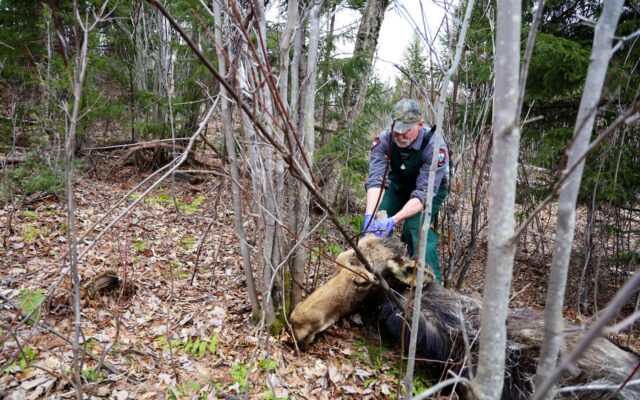
State biologist expects high survival rate of moose calves this year
By Julie Harris, Bangor Daily News Staff
Winter ticks that plague juvenile moose are at one of the lowest levels researchers have seen in 11 years. It’s the second year in a row that the tick counts on moose have been relatively low.
Animals with a high tick load can lose from 25 to 30 percent of their body weight during the winter months, mainly because they spend their time standing, scratching and grooming themselves, trying to get rid of the biting beasts, according to Lee Kantar, Maine’s moose biologist.
When the moose are so active, they use energy rather than conserve it in the cold months, jeopardizing their overall health.
Kantar has just returned from moose hunting Zone 4, which is northwestern Maine, where researchers put radio collars on 72 “short yearlings,” defined as moose born last year that are not quite 12 months old yet.
The state has been putting radio collars on young moose for 11 years, taking blood and hair samples, checking for winter ticks and examining the overall health of the animals. It’s part of the Maine Department of Inland Fisheries and Wildlife’s herd management program.
A helicopter, a pilot and one crew member came from New Zealand to be part of Kantar’s team to find the moose. Another crewman came from Alaska. Once they finished the state’s project, the helicopter and crew went to Mattamiscontis and Alder Stream areas to help Penobscot Nation biologist Ben Simpson collar 20 adult moose on tribal land for the first time.
“There is no lack of moose on the landscape,” Kantar said Friday. “There are moose tracks everywhere.”
The mild winter with little snow is making it easier for moose to move around, so between that and the lower tick loads, the short yearlings the scientists collared were found to be larger than expected, Kantar said.
One female weighed more than 500 pounds. Usually they average closer to 400 pounds, he said.
Being heavier gives the calves a better chance of surviving winter ticks. The calf-cow ratio was more than 50 calves per 100 cows, he said. The crew found two sets of twins. He would like to see more calves, but he expects a high survival rate this year of the ones out there, he said.
Kantar also expects the moose population to increase, which is good for the herd but bad regarding the winter tick problem. The higher population of moose means more winter ticks.
“Hunting doesn’t drive the population of moose. It’s the winter ticks,” he said.
The number of moose permits and the number of animals killed in 2023 were both up from 2022. There were 3,555 regular season permittees who killed 2,279 moose in 2023, with a success rate of 64 percent. Adding in the adaptive hunt permits and harvest, the totals were 4,105 permittees who killed 2,440 moose, making the success 59 percent overall.
In 2022, 3,530 regular season permittees killed 2,199 moose, with a success rate of 62 percent. Adding in the adaptive hunt permits and harvest, the overall totals were 4,050 permittees who killed 2,334 moose, with a success rate of 58 percent.
Simpson and Kantar support each other’s work, and both use University of Maine graduate students to help with their research.
Simpson has done organized captures of other animals on tribal land, but this is his first time putting collars on moose to do research the tribe has not done before. The Penobscot Nation received a $333,000 grant for the two-year project to follow the 12 cows and eight bulls Simpson and his team collared.
“As a sovereign nation, we do not want to have to rely on the state for data. We want to have our own, so we can answer our own questions and make our own wildlife management decisions,” Simpson said Friday.
Simpson hopes to track moose movement and how the herd uses its habitat. His team also took blood and hair samples similar to what Kantar’s team did in northern Maine, but also checked for respiratory diseases in the adults. The collars drop off after two years, he said.
Mattamiscontis and Alder Stream are two of the tribe’s largest land areas, and both have high moose densities, said Simpson, who has been the Penobscots’ wildlife biologist since 2019.
Putting collars on the 20 adults is one of three moose projects Simpson is doing. The researchers are dragging sheets through the woods to figure out the density of winter ticks there. This is the project’s fifth year and the tribe just received funding to extend it four more.
The study looks at tick density over time and how the weather and tree harvest types affect it.
The third project is a two-year camera study of moose to estimate winter ticks in the population. A University of Maine master’s degree student is doing the field work. Using the 76 game cameras, researchers can determine the percentage or rate on a numerical scale of the amount of hair loss winter ticks cause on moose, Simpson said.
They already have thousands of moose photos in the first year, he said.
Simpson also has developed a different method for tick sampling in a clearcut because he wants more information than walking in straight lines can obtain. He identifies eight points in the clearcut, then walks several concentric circles around each point. That way he knows exactly where the ticks were found and what the habitat was like near them.
He said his idea is catching on in the scientific community. He knows of a University of Massachusetts student who is using it instead of the traditional way of walking in lines too.
“Counting ticks on the landscape is important for knowing densities. It’s also an inexpensive way to collect information,” Simpson said.